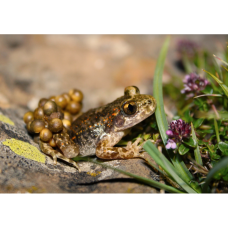Les séminaires de l’ISYEB accueillent Laurence Després, Professeure au Laboratoire d’Ecologie Alpine, Université de Grenoble, Alpes

Soutenance de thèse en amphithéâtre Rouelle

Soutenance de thèse en amphithéâtre Rouelle
Hybrid speciation and adaptive radiation along an elevational gradient in an alpine butterfly
–
Spéciation hybride et radiation adaptative le long du gradient altitudinal chez un papillon alpin
Abstract: Speciation with gene flow is more common than previously thought, but the mechanisms by which phenotypic divergence and reproductive isolation arise are poorly understood. Furthermore, the role of hybridization in species diversification and adaptive radiation is debated. I will first highlight the role of hybridization in the diversification of Coenonympha butterflies along altitudinal gradients in the Alps (4 lineages), and discuss differential patterns of genomic introgression in contact zones. The hybrid lineage presents an intermediate morphology between the parental species, while its climatic niche is more similar to the alpine species C. gardetta. Unexpectedly, although the hybrid genome is mostly constituted of the lowland species genome (70% C. arcania and 30% C. gardetta), introgression rates in contact zones were much higher between the hybrid lineage C. macromma and C. gardetta (2 alpine species) than between C. macromma and C. arcania (alpine and lowland species respectively). Interestingly, both alpine species emit volatile compounds (Octadecanal, Octadecanol and Eicosanal) that are absent in the lowland species, suggesting pre-mating isolation mechanisms between the alpine and lowland species through olfactory cues. Evidence for local adaptation to cold temperature was found by measuring higher warming-up rate (thorax temperature in controlled conditions) with increasing elevation in the lowland and hybrid species. The alpine species C. gardetta has the highest warming-up rate, suggesting that temperature is a main driver of adaptive radiation in this butterfly alpine species complex.
–-
Résumé: Si la spéciation sympatrique est à présent largement acceptée, les mécanismes qui génèrent la divergence phénotypique et l’isolement reproducteur restent peu connus. De plus, le rôle de l’hybridation entre lignées divergentes comme moteur de la radiation adaptative reste débattu. Après avoir montré le rôle de l’hybridation dans la diversification des papillons alpins du genre Coenonympha (Nymphalidae ; Satyrinae), je discuterai des différents patrons d’introgression observés dans les zones de contact entre espèces. La lignée hybride présente une morphologie intermédiaire entre les espèces parentales, tandis que sa niche climatique est plus proche de l’espèce alpine C. gardetta. Bien que le génome hybride soit principalement constitué du génome de l’espèce de basse altitude (70% C. arcania et 30% C. gardetta), les taux d’introgression dans les zones de contact sont plus élevés entre la lignée hybride et C. gardetta qu’avec C. arcania. Les deux espèces alpines émettent des composés volatils (Octadecanal, Octadecanol et Eicosanal) absents chez C. arcania, suggérant des mécanismes olfactifs d’isolement pré-zygotique entre les espèces alpines et de plaine. Une capacité de réchauffement plus rapide est observée chez les papillons de haute altitude (intraspécifique), ainsi que dans l’espèce alpine C. gardetta (interspécifique), ce qui suggère que la température est un facteur sélectif important dans la radiation adaptative de ces papillons le long du gradient altitudinal.



